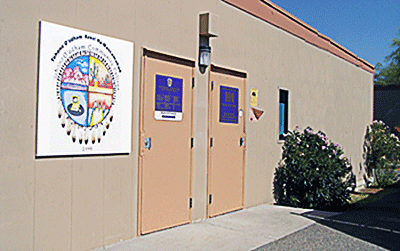
- Details
- By Native News Online Staff
Charity Offering Native Student Scholarships and College Readiness Programs to Increase Number of Native Americans With A Higher Education
DENVER — The American Indian College Fund (College Fund) has received a $350,000 contribution from AT&T to continue its “Braided Success: Fostering Native Student Success from High School to College and Career” program.
The Braided Success program helps fund high school and college students in the Tohono O’odham Community College in Sells, Ariz. and the College of Muscogee Nation in Okmulgee, Okla. to achieve their quest for higher education.
AT&T’s contribution will also allow the College Fund to contribute $100,000 to the Braided Success program, providing scholarship support to American Indian and Alaska Native (AIAN) students from Oklahoma and Arizona seeking to attend a tribal college (TCU) or mainstream institution located in their home states.
“AT&T is on the leading edge of engaging best practices supporting career pathways for indigenous students through its support of the College Fund’s student success programming. This partnership builds on our shared vision of helping students achieve their dreams,” Cheryl Crazy Bull, president and CEO of the American Indian College Fund said.
The highly successful program, in its first three years, allowed the College of Muscogee Nation to partner with three local high schools, which offered three dual enrollment programs. Of the 157 Native high school student participants, 33 percent took college courses through the dual-enrollment program. Participants also enjoyed college visits.
Similarly, Tohono O'odham Community College partnered with two local high schools to launch its S.T.A.R.T. program—Students Thriving, Achieving, and Rising Together. Thirty-eight percent of all partner high school students are served by S.T.A.R.T., and of that number, 42 percent of the students participated in the dual-enrollment program with the community college. Students also enjoyed after-school programs and tutoring sessions.
The result was that students who participated in the TCU’s programs graduated from high school at rates more than 20 percent higher than Native Americans nationally.
By continuing the strong relationships forged between college the high schools and TCUs, the Braiding Success initiative also better prepares students who transition to college for an easier transition to higher education and employment.
“AT&T has a long history of supporting initiatives that help Native American students graduate from high school and succeed in college and career,” said Tom Brooks, vice president of external affairs, AT&T. “We’re proud to further our commitment to Native communities with this contribution and connect Native youth to educational pathways that lead to careers in the 21st century workforce.”
More Stories Like This
Native Forward Scholars Fund Announces 2025 Students of the Year at Empowering Scholars SummitNavajo Nation Speaker Curley and Council Delegate Dr. Nez Join Education Leaders to Address Federal Budget Cuts
Mackie Moore (Cherokee) Named Interim President of Haskell Indian Nations University
Mohawk Students File Legal Suit Over Changes Impacting Access to Federal Financial Aid
Trump Administration Proposes Deep Cuts to Tribal College Funding, Threatening Their Survival
Help us tell the stories that could save Native languages and food traditions
At a critical moment for Indian Country, Native News Online is embarking on our most ambitious reporting project yet: "Cultivating Culture," a three-year investigation into two forces shaping Native community survival—food sovereignty and language revitalization.
The devastating impact of COVID-19 accelerated the loss of Native elders and with them, irreplaceable cultural knowledge. Yet across tribal communities, innovative leaders are fighting back, reclaiming traditional food systems and breathing new life into Native languages. These aren't just cultural preservation efforts—they're powerful pathways to community health, healing, and resilience.
Our dedicated reporting team will spend three years documenting these stories through on-the-ground reporting in 18 tribal communities, producing over 200 in-depth stories, 18 podcast episodes, and multimedia content that amplifies Indigenous voices. We'll show policymakers, funders, and allies how cultural restoration directly impacts physical and mental wellness while celebrating successful models of sovereignty and self-determination.
This isn't corporate media parachuting into Indian Country for a quick story. This is sustained, relationship-based journalism by Native reporters who understand these communities. It's "Warrior Journalism"—fearless reporting that serves the 5.5 million readers who depend on us for news that mainstream media often ignores.
We need your help right now. While we've secured partial funding, we're still $450,000 short of our three-year budget. Our immediate goal is $25,000 this month to keep this critical work moving forward—funding reporter salaries, travel to remote communities, photography, and the deep reporting these stories deserve.
Every dollar directly supports Indigenous journalists telling Indigenous stories. Whether it's $5 or $50, your contribution ensures these vital narratives of resilience, innovation, and hope don't disappear into silence.
 The stakes couldn't be higher. Native languages are being lost at an alarming rate. Food insecurity plagues many tribal communities. But solutions are emerging, and these stories need to be told.
The stakes couldn't be higher. Native languages are being lost at an alarming rate. Food insecurity plagues many tribal communities. But solutions are emerging, and these stories need to be told.
Support independent Native journalism. Fund the stories that matter.
Levi Rickert (Potawatomi), Editor & Publisher

